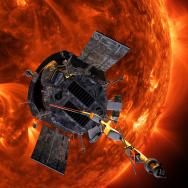Five years ago, on Aug. 12, 2018, the Parker Solar Probe launched from Cape Canaveral and hurtled toward the sun—to travel closer to our star than we’ve ever been before.
Ever since, the plucky little spacecraft has been reshaping what we know about stars, about our own sun, and about how stars affect the solar systems around them.
The Parker Probe is named for the late Prof. Eugene Parker, a University of Chicago scientist who became known for proposing the concept of the solar wind before going on to a decades-long career unravelling the mysteries of the physics of stars. It is the first spacecraft that was named for a living person; at the age of 91, Parker traveled to Florida to watch his namesake spacecraft launch.
The spacecraft, built by Johns Hopkins Applied Physics Laboratory to withstand the intense heat and radiation coming off the sun, must constantly orient itself to keep its shield between itself and the star. (Except for one especially tough instrument, built by UChicago alum Justin Kasper, which peeks around the edge of the craft to scoop up particles of the solar wind).
It has repeatedly broken its own records for the fastest human-made object. In 2024, it will reach a top speed of about 430,000 miles per hour (700,000 kilometers per hour) as it flies to within 3.9 million miles (6.2 million kilometers) of the sun’s surface. That’s fast enough to travel from New York to Tokyo in less than one minute. (You can see where the Parker Solar Probe is in real time here.)
In December 2021, the Parker Probe reached the atmosphere of the sun. Since then, it’s been looping around the sun, drawing closer each time, and sending back tons of data about everything it encounters.
“Every close encounter opens up new opportunities to understand better how the Sun works and how it affects us here on Earth and beyond,” said Nour Raouafi, the Parker Solar Probe project scientist at Johns Hopkins Applied Physics Laboratory in Laurel, Maryland.
Here are a few of its findings so far:
Magnetic funnels litter the sun’s surface. Among the first findings from the Probe was strange flips, or switchbacks, in the magnetic field as the spacecraft approached the sun. According to NASA, during Parker Solar Probe’s 6th flyby of the sun, it found that these flips aligned with magnetic “funnels” in the solar surface. These funnels emerge from between structures called supergranules – giant bubbles on the sun in which hot plasma from the solar interior rises up, spreads out across the surface, cools and then sinks back down.
It’s possible that these funnels hold the key to understanding why the corona of the sun is so much hotter than the surface—a mystery that has plagued science for more than half a century.
The sun’s corona is wrinkly. The “surface” of the corona isn’t shaped like a smooth ball but contains spikes and valleys that wrinkle the surface. These turned out to be coronal streamers – giant plumes of solar material rising through the sun’s atmosphere. The results, NASA said, are reshaping what we know about the sun’s atmosphere and how it transforms into the solar wind.
There are way more energetic particles flying off the sun than we realized. Particles are flung off the surface of the sun at extraordinary speeds. We only rarely get them on Earth, but Parker Probe’s instruments have picked up huge amounts of these particles. Not only are they much more numerous than we realized, but they come in many different types and they often take very circuitous routes as they’re captured by the flipping magnetic fields.
Venus has a very long plasma tail. The Parker Probe uses Venus to round the corner for its trips around the sun, so it’s taken groundbreaking data on Venus, too. It has imaged the dust ring around Venus, made measurements of the radio waves in the Venus atmosphere, and helped scientists better understand the geology and minerology of Venus. It’s also studied the comet-like tail of plasma that trails Venus and found it’s huge—equivalent to the radius of the planet.
Parker Probe also took the first-ever images of Venus’s surface in visible wavelengths—that is, capturing what we would be able to see if humans approached Venus.
What powers comets and where they came from. From its position in space, Parker Probe had a chance to catch closeups of a comet passing by and is shedding light on the origins of the Gemini meteor shower, which light up the skies above Earth every winter.
A front-row seat
In June 2023, Parker Probe completed its 16th orbit of the sun and is currently looping around Venus to prepare for another encounter. This is an exciting part of the mission for scientists. In the first few years of the mission, the sun was in a less active part of its cycle. But it’s expected to stir in the coming years, giving Parker Probe a front-row seat to a spectacular show of sunspots, solar flares, and solar eruptions.
Before Eugene Parker passed away in 2022 at the age of 94, he routinely pored over the data coming in from the spacecraft as it came in. NASA mission scientist Nicky Fox often visited Parker at his Hyde Park residence to update him on the latest findings.
“You rarely have a space mission that doesn’t come up with the unexpected, and it’s actually going to get more exciting as the mission goes on and crosses into regions that spacecraft have never been in before,” Parker said in 2019. “It’s just fascinating every step of the way.”

